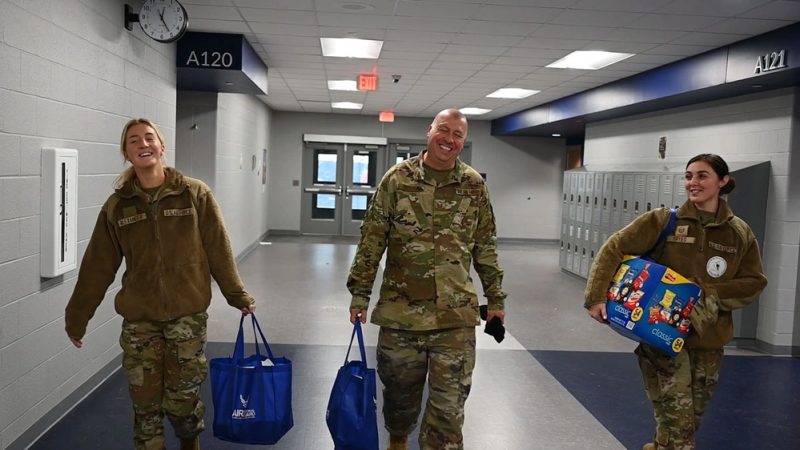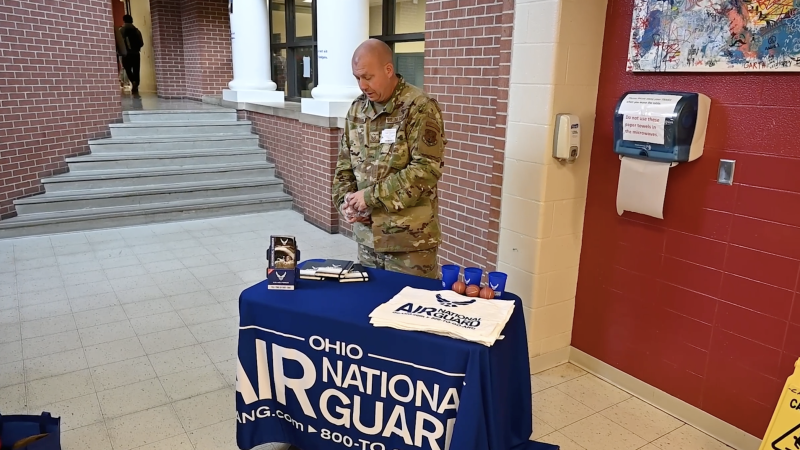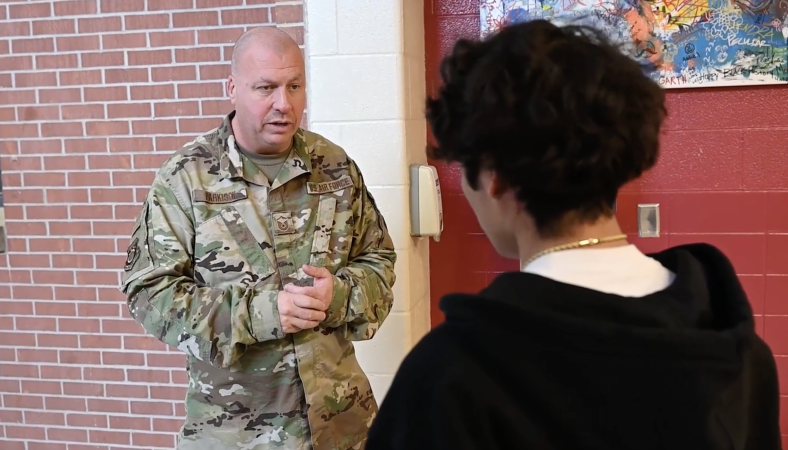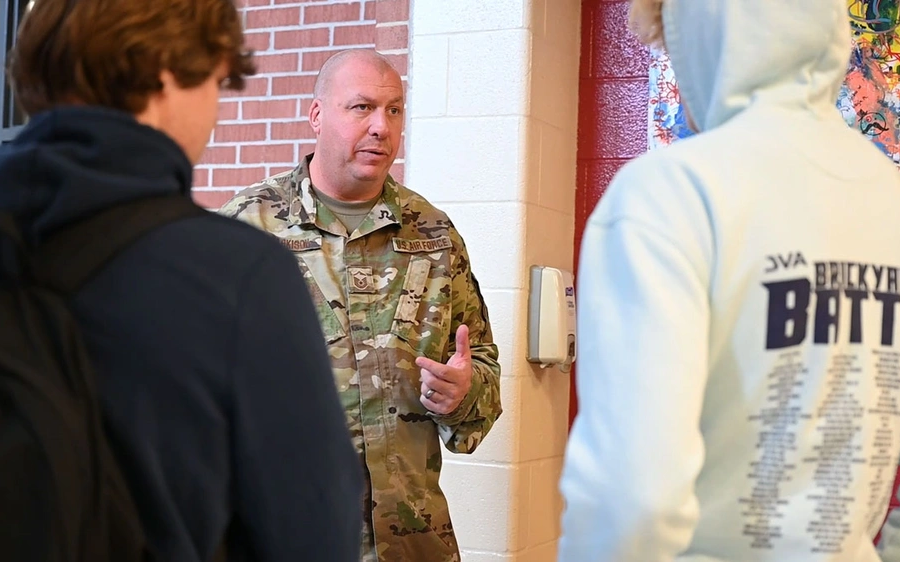Like any other Air National Guard recruiter, Master Sgt. Todd Parkison got a “Century Club” award when he brought in 100 recruits. Then he got another at 200, and a third at 300. After that, he stopped getting Century Club awards.
In August, the production superintendent with the Ohio Air National Guard’s 121st Air Refueling Wing, brought in his 700th Airman, more than any other Air National Guard recruiter in history, and perhaps more than any Air Force recruiter—period.
But after 13 years, Parkison isn’t driven by the numbers, he told Air & Space Forces Magazine. Instead, he sees recruiting as a way to give others the same opportunities he had as a 19-year-old just laid off from his job as a machinist.
Parkison’s father, an Army National Guard veteran, encouraged him to join the Air National Guard where he could perform similar work in the aircraft maintenance machine shop. Parkinson enlisted in 1999 and got a confidence boost from completing basic training and tech school. That confidence later helped him graduate college with honors, paid for by the Ohio National Guard’s education benefits.
“The growth that I had at basic training and tech school allowed me to really know that I could do that, that I could have the confidence to get my degree,” he said.
Parkison eventually reached master sergeant and ran the KC-135 tanker machine shop at Rickenbacker Air National Guard Base. Around 2011, he applied for a recruiting position, even though it meant dropping a rank to technical sergeant.
“The Air National Guard did so much for me,” he said. “I wanted to give back to the community in a way that would help individuals change the course of their lives.”

Recruiting tech school at San Antonio, Texas, was a challenging experience where Parkison had to memorize an entire sales script on just the third day.
“I remember looking at the clock thinking ‘if I drive straight through, I could be home tomorrow night, back at my old shop,’” he said.
But Parkison persevered, and a supervisor named Master Sgt. Lawrence Wright taught him a crucial lesson: ask a few questions, then let the applicant talk and answer questions as they go.
“I think every salesperson comes up with their own way,” Parkison said. “And once I was able to develop the way I sold the Air National Guard, it was pretty easy for me.”
Unlike Active-Duty recruiters, who serve a few years before rotating back to their usual jobs, Air National Guardsmen can serve as recruiters for decades. But early in his tenure, Parkison noticed an issue: recruiters could recruit for only their assigned base—Rickenbacker, in Parkison’s case—but not the entire Ohio Air National Guard.
“Why couldn’t I put someone on my waiting list in Mansfield or Springfield or Toledo?” he asked. “So we as Ohio came up with this concept where we’re going to be a whole state recruiting force.”
After that, Parkison really started doing numbers, taking the Air National Guard top accessions award four times between 2013 and 2017. Being a volleyball coach helped when one of Parkison’s players became one of his recruits.
“She said ‘My Army National Guard recruiter stood me up and didn’t take me to MEPS [Military Entrance Processing Station],’” he recalled. “So I was able to flip her to the Air National Guard and she’s doing really well.”
In fact, two of the people working for him in the recruiting office today are Airmen that he himself recruited.
“Master Sgt. Parkison’s impact has been huge,” one of those recruits, Tech Sgt. Adria Bivens, said in a Dec. 11 video about Parkison’s achievement. “Seven hundred, that is 700 career paths, that’s 700 lives that he’s changed. One of those could be the next command chief, there’s a commander in there somewhere.”

The COVID-19 pandemic hit military recruiters hard since they could no longer go to schools and events in-person. But the Ohio Air National Guard fell back on its social media platforms, which helped bring in virtual enlistments.
“I think that was how we were able to stay in the community, because Ohio is still doing pretty well compared to the rest of the nation,” Parkison said.
The challenge is the MEPS process, where recruits are medically screened before joining the military. Many recruits need a waiver for medical conditions such as allergies or asthma, but processing waiver requests takes time and paperwork.
“When somebody is disqualified, you have to make sure you’re staying on top of that package to see it through to the surgeon general and then back to us,” Parkison said. Otherwise, a recruit might “sit in a certain spot for months, because that can happen if you’re not paying attention.”
The long medical processing time for recruits has caught the attention of top Air Force officials and federal lawmakers. In 2023, the Air Force hired about 60 contractors to work in and around MEPS locations to help with the paperwork so that recruiters can get back to recruiting. A similar approach seems to be helping in Ohio, where a civilian contractor works medical waivers full-time.
“That’s going to take waivers off our recruiters, so they don’t have to be in the computer all the time,” Parkison said. “They can be out there in public, doing events, going to schools and not having to worry about five or six applicants that have to go through the SG waiver.”

Another helpful program has been the state-funded “Bucks for Buckeyes,” where current or former Ohio Air or Army National Guardsmen get $2,000 for referring new recruits. But most of their leads come from the friends of recruits, and that word-of-mouth comes down to treating potential candidates right.
“That’s what I try to teach young recruiters: the most important person in your life right now is that applicant, because the most important thing in that applicant’s life is joining the Air National Guard,” he said. “If you just look at them as a number, or ‘it’s six o’clock, I’m off work, I’ll call you tomorrow,’ you’re not going to get their friends. But if you look at them as your number one priority, then they’re going to feel like you care about them, and they’re going to bring in their friends.”
It used to frustrate one of Parkison’s old bosses that he would talk to anybody, regardless of whether or not they could qualify for service.
“If someone walked in weighing 270 pounds, I would spend an hour and a half with them,” he said. “That guy is going to say ‘he took the time to talk to me,’ where everyone else disqualified him over the phone, and he’s going to tell his friends that might be qualified about it.”
And sometimes even the people who are disqualified come back; one of his recruits lost 80 pounds to join the air transportation career field.
There may have been even more accomplished recruiters in the past, but National Guard records go back only about 20 years, Parkison said, and no one else is close to his mark. Since Active-Duty recruiters serve only a few years, it stands to reason that Parkison may be the most accomplished recruiter in Air Force history, as far as records show.
Parkison’s advice for recruiters boils down to three words.
“Honest, responsive, and available,” he said. “If you do those three things, I think you’ll be a successful recruiter.”
